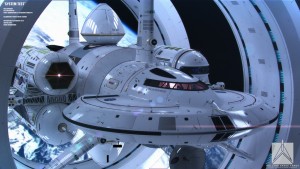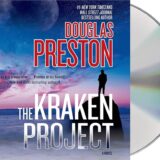In the science fiction community, we often call it “FTL” and sometimes confuse the mundanes who don’t know the acronym. Still, the idea does get covered by the mainstream (e.g. at the Washington Post no less!), at least when someone at NASA (Harold White) is playing around with the concept and getting an artist (Mark Rademaker) to help to show off starship designs.

So yeah, this got picked up by every news outlet there is, it seems, which I approve of. Interstellar travel should be a concept that seeps into the public consciousness in a way that is a little more than “just science fiction.” But is it science?
Yes, it is.
The basic notion is related to the Alcubierre Drive, which is literally a warp drive right out of Star Trek. You see, there’s a trick here, that in practical terms is no trick. Einstein’s theories of special and general relativity don’t permit anything to accelerate to light speed, let alone any faster; getting to light speed would take an infinite amount of energy. Einstein’s theories have a loophole, however, which seems to be real — space itself may be shrunk in front of a ship, reducing the distance, while expanding the space behind it. The ship never has to travel faster than light in order to get somewhere effectively faster than light. Neat, huh? (This same principle, by the way, is the basis of cosmic inflation, which lets the stuff in the early universe to expand apart in effect faster than light speed.)
From what we understand about how space works, it is theoretically possible to cheat the universal speed limit. Furthermore, it doesn’t seem to require all the crazy time dilation issues of conventional relativistic travel, or place travelers under incredible accelerations that would destroy them. You ride along in a warp bubble and just move the space around, not so much yourselves.
The practical problem is that we haven’t actually figured out how to warp space in any meaningful way. Large amounts of mass or energy can do it, and we’d also like to have exotic matter or dark energy that can warp things in a different manner, but so far a warp drive must be considered speculative, within the camp of science fiction, without this ability. But who knows? NASA is working on that, too.
Personally, I think there’s a lot of space (and science fiction territory) to explore with slower-than-light starships. Relativity itself provides another loophole, assuming high enough (relativistic) velocities: time dilation. Travelers moving arbitrarily close to light speed can reach arbitrarily large distances in finite times. To observers on Earth, a space ship traveling at close to c (light speed) may take a little over four years to reach the closest stars beyond our sun, but the time is shorter to those on the ship. Now, the energies and engineering required to safely accelerate a starship to close to light speed may be overwhelmingly challenging, but they don’t require generating warp fields, something we don’t quite yet know how to do in a significant way.
Anyway, I’m pleased by developments that have given us science supporting at least one loophole to Einstein’s speed limit. If you can’t beat ’em, cheat ’em. Be skeptical about this in the short term, but don’t say it’s impossible! And let’s see more “science fiction” in the news and discussed as actually science-based when it is! That’s a terrific development.











Mike,
Great explanation. I always do mental backflips when I see the mainstream news documenting the evolution of our world from science fiction to reality. How breathtaking it must be for all those science fiction fans of the twenties and thirties to see their fantasies of the future slowly inching closer to the present.
Thanks,
RKT